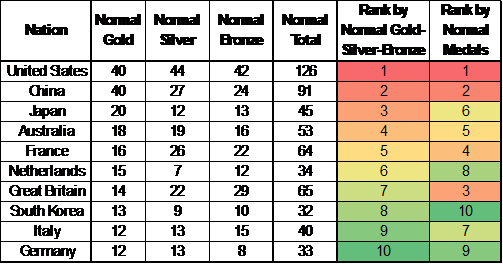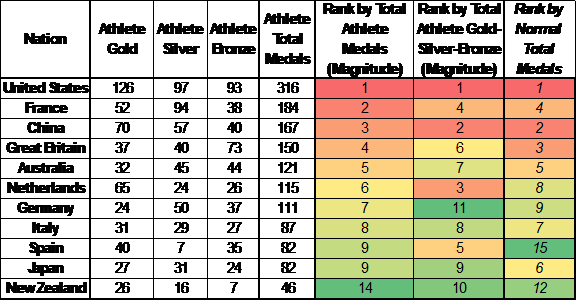Why magnitude matters in disasters, and what the medal tally of the 2024 Paris Olympics has to do with it
After major disasters around the world, the CEDIM Task Force Team is often involved in assessing them immediately after they occur, estimating the consequences, tracking their development over time and identifying the most important factors that determine their impact. Our various loss models, which we have developed in recent years for different types of catastrophes, play a special role in determining the costs and thus estimating the losses more accurately. We started this internally in 2009 and officially launched ou Forensic Disaster Analysis (FDA) in 2011.
One of the most important indicators of a disaster is the magnitude of a particular hazard, as well as the exposure and number of people affected and the vulnerability of the exposure. The magnitude of an event often determines the extent of damage, be it the magnitude of an earthquake at a certain depth, the wave height of a tsunami (e.g. Tohoku 2011), the wind speed of a tropical storm (e.g. Irma 2017), the depth or speed of water in floods such as the Ahr flood 2021, or the number of deaths or daily cases of infection during the COVID-19 pandemic. However, if a large-scale event (very high hazard potential) occurs in a place where there are few people or infrastructure, the impact will be relatively small. Mapping and assessing the extent of damage is therefore critical for planning, managing and recovering from an event.
Of course, major disasters like the Olympic Games do not happen every year!
At the Olympics, gold, silver, and bronze medals are awarded for each event, and the results are broadcast worldwide in the media. There are many different ways that countries count (standardize) the medals in the medal tally. The most common way is to count gold medals and/or the number of medals in first place (see Figure 1). Another way is to divide the medals by the number of athletes or the population of the country. However, there is one important parameter that is rarely measured: The magnitude of a medal!

As Australians, we are often strongest in the swimming events, which are sometimes swum individually or in 4-person relays. So how about we take the number of medal winners and count a gold medal as 4 gold medals for a relay (or, if extra athletes are used in the heats, simply the number of athletes who receive a medal)? In basketball, a gold medal is awarded to the entire team, so it would count as 12.
In terms of gold medals, Germany is ranked 10th in the world and 9th in the medals tally on the official Olympic website. Here, however, the "adjusted" top 10 medal count by "magnitude" (if the number of medals per athlete were taken into account) would put Germany in 7th place (Abb. 2).

In the "adjusted" Olympic medal tally, Spain, which was very successful at the Games in men's soccer and women's water polo, jumps from 5 gold medals (if a team is counted as one - as usual) to 40 gold medals in the "adjusted" form, and from 15th to 5th place in the gold, silver, and bronze medal rankings. India climbs from 73rd to 20th place in the medals table (field hockey bronze) and France jumps to 2nd place in the medals table thanks to a heroic team performance. In the end, of course, the best measure of a great Olympics is the number of impressive Olympians and Paralympians who competed at Paris 2024, and all should be proud, whether they finish first or last.
Although the media and the official website always measure the medal haul of the event by the number of gold, silver and bronze medals, the team aspect and the size of the team is probably an important measure of the medal haul at the Olympics - as it is when analyzing disaster risk. Similarly, in the event of a major catastrophe, we will contribute as a team from different disciplines and with different expertise to train our models (collect data, normalize and develop new metrics) and work around the clock to provide timely analysis.
Associated institute a KIT: Institute of Photogrammetry and Remote Sensing (IPF) and CEDIM Spin-Off Risklayer
Author: Prof. James Daniell (Aug. 2024)

